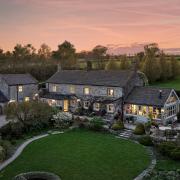Ambitious plans are made to tackle problems along the 12-mile length of the River Skell

When thirteen rebellious monks set up home beside the River Skell, near Ripon, they can have had little idea of the trouble they would be causing almost 900 years later. Founded in 1132, Fountains Abbey had grown to become one of the richest in England by the time Henry VIII ordered its dissolution in 1539. Today the abbey ruins and the adjoining water gardens at Studley Royal are a World Heritage Site attracting more than 350,000 visitors every year. However, the monk’s choice of the riverside location has created a multi-million pound headache for its current owners, the National Trust.
Since taking over the ruins in 1983 the Trust has spent around £2.5million dredging the river and repairing defences in a not always successful attempt to protect them. Despite all the money and effort there have still been times when the abbey has been under more than 6ft of water and thanks to evolving farming practices and climate change things are getting worse, says the general manager Justin Scully.
Now with help from the National Lottery the Trust is joining forces with local farmers, landowners, community groups and the Nidderdale Area of Outstanding Natural Beauty to come up with a plan the tackle problems along the entire 12 mile length of the Skell from its source on the moors above Dallowgill all the way down to Ripon, where it meets the River Laver and eventually joins the Ure. He said: ‘It means we will be working outside our own property but you have to treat the river as a whole. Water is no respecter of boundaries and nor is the wildlife which uses the river and will benefit from improvements.’
Sarah France, the Trust’s World Heritage Site co-ordinator, said: ‘The River Skell flows through the heart of the landscape but historic sites and homes have been hit by serious flooding several times in recent years. If we don’t find a different way to look after the valley irreplaceable heritage could disappear forever. Unfortunately floods like these are not one-offs.’

A major problem at Fountains is silt, washed down from the moors and farms further upstream, clogging the water courses, causing them to back up after heavy storms. ‘We call it silt because that is what it is by the time it gets here,’ said Justin. ‘But really it is someone else’s productive soil, literally valuable farmland which is being washed away by the river. It’s a problem we are working on continuously here but a much better solution must be to stop the silt coming down in the first place by keeping the soil where it belongs, on the land.’
The aim is to come up with an overall scheme to control the flow of the river using natural methods, such as restoring water-retaining moorland mosses and planting woods so that rainwater is released more slowly through the soil into the river and perhaps even altering its course slightly to slow it down. It is hoped this will add up to a system that will not only protect Fountains from flooding but also safeguard communities downstream, including the city of Ripon itself.
So far the Heritage Lottery Fund has given £128,000, which will be matched by the Trust and other donors, to firm up the plans. They are due to be ready by next year when it is hoped that further lottery grants, again matched by other donations, will provide £2.5million to pay for them.
As well as flood defences the final scheme will also include repairs to paths along the riverside, including at Eavestone Lake, and elsewhere up the valley and improvements to wildlife habitat, working with local groups.

Justin added: ‘Most of the money will not actually be spent on National Trust land but this is a plan that will help everybody in the area as well as visitors. It is a beautiful valley but not always easy to access. Some of the paths are very overgrown and difficult to follow in their current state. I hope that in five to 10 years’ time people will see a valley that is much easier to enjoy, an improved natural environment and more wildlife. I also hope that local communities will be connecting more with the valley through schools and village groups all getting involved.
‘There are only 1,200 or so World Heritage Sites. That means we have one of the 1,200 most important heritage sites on the planet and we need to look after it.’



























